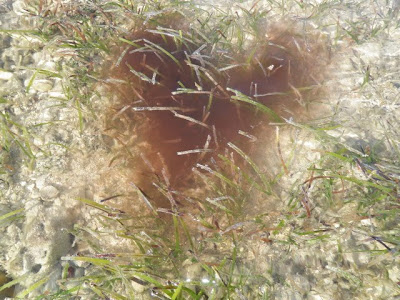Hello everyone. My Coral Adventures shifts back to Indonesia, where on Sundays, me and my friend like going to the local fish stores. My business partner/friend (name is Gili) has a 240 gallon plexiglass tank that I gave him while back. It is set up as a fish only tank and Gili does weekly water changes. Sundays are perfect for driving around Jakarta. You don't want to know about Jakarta traffic on weekdays, it is horrendous!

We use these five gallon containers to transport the water.
 The water is sold at one of the stores. That hose connects to a reservoir and quite many reefers come to buy the water. The water originally comes from around Jakarta. Jakarta Sea World filters the water and sells it to the stores.
The water is sold at one of the stores. That hose connects to a reservoir and quite many reefers come to buy the water. The water originally comes from around Jakarta. Jakarta Sea World filters the water and sells it to the stores.  LFS's in the US could do the same. I would ask the customers to bring in their dead coral skeletons for credit. Then put together these coral "sculptures" as part of the rockwork in our tanks. After some time, it would be all coralline encrusted and look really nice. I think this would be perfect for nano tanks!
LFS's in the US could do the same. I would ask the customers to bring in their dead coral skeletons for credit. Then put together these coral "sculptures" as part of the rockwork in our tanks. After some time, it would be all coralline encrusted and look really nice. I think this would be perfect for nano tanks! All tanks are made from glass. Acrylic is not readily available and very pricey. Here you see some local common fish, cardinals, rabbitfish, moorish idol, etc..
All tanks are made from glass. Acrylic is not readily available and very pricey. Here you see some local common fish, cardinals, rabbitfish, moorish idol, etc.. So this was kind of sad. Local wildlife is not closely monitored in Indonesia. But in Bali, turtles are revered by the Balinese Hindus, so there is much more awareness. Turtles are a favorite food item in most parts of Indo.
So this was kind of sad. Local wildlife is not closely monitored in Indonesia. But in Bali, turtles are revered by the Balinese Hindus, so there is much more awareness. Turtles are a favorite food item in most parts of Indo. Another disturbing site, color dyed trachys. Coloring corals was very popular some years ago, especially with leather corals. The practice has tapered off quite a bit in the years, so that tells me that reefers are rejecting the bad practice. Part of the problem was that unscrupulous store owners were selling the colored corals without telling the customers!
Another disturbing site, color dyed trachys. Coloring corals was very popular some years ago, especially with leather corals. The practice has tapered off quite a bit in the years, so that tells me that reefers are rejecting the bad practice. Part of the problem was that unscrupulous store owners were selling the colored corals without telling the customers! Corner shot of a display tank. Note the fully opened fox coral and the green bubble coral. Recently, Cites has determined that Nemenzophyllia turbida can be sent under the bubble coral Plerogyra sinuosa. Somehow Cites has determined that taxonomically, these two corals are the same or similar genus and species.
Corner shot of a display tank. Note the fully opened fox coral and the green bubble coral. Recently, Cites has determined that Nemenzophyllia turbida can be sent under the bubble coral Plerogyra sinuosa. Somehow Cites has determined that taxonomically, these two corals are the same or similar genus and species.  Lobos and fungias grouped together stands out, all part of positioning your corals so they look visually appealing to the eye - nice!
Lobos and fungias grouped together stands out, all part of positioning your corals so they look visually appealing to the eye - nice! A titan trigger. These are commonly eaten as "chicken fish" in Indonesia, and they do taste like chicken.
A titan trigger. These are commonly eaten as "chicken fish" in Indonesia, and they do taste like chicken.  Assorted butterflies. Surprisingly, many people come by and buy these common fish. Most likely they end up dying and are simply replaced with new ones.
Assorted butterflies. Surprisingly, many people come by and buy these common fish. Most likely they end up dying and are simply replaced with new ones. Like many other places around the world, the fish stores are concentrated in a certain area. This makes it easy for the customers.
Like many other places around the world, the fish stores are concentrated in a certain area. This makes it easy for the customers.Conclusion,
Ok guys that is it for today. Stay tuned for more posts of Jakarta LFS's in the coming days.
Cheers,
Eddie






































 The tide was going out and the mangrove roots were starting to be exposed.
The tide was going out and the mangrove roots were starting to be exposed.



















